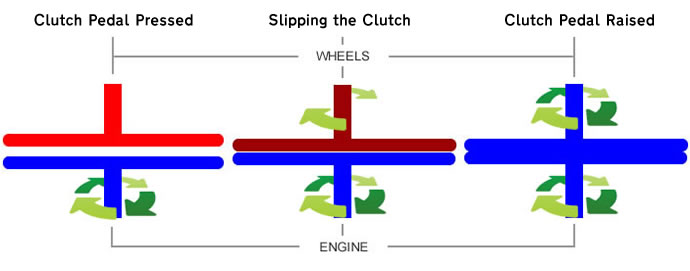A car engine is spinning when turned on regardless of whether the vehicle is moving or stationary, this is because of the clutch.
If the vehicle is stationary, obviously so too are the wheels. A clutch essentially allows the connection of a moving object such as a rotating shaft, to a non-moving or slower moving shaft to ultimately allow them to rotate at the same speed by slipping.
The clutch can be thought of as two flat plates. One that is connected to and spinning with the engine and the other connected to the static shaft which is connected to the stationary wheels. The two plates are pushed together slowly and very tightly making a single connection when the cars clutch pedal is raised.
The clutch must be raised slowly to allow the two plates to join slowly else the static plate connecting to the rotating plate will make the engine stall or wheel spin will occur.
This form of clutch control is called slipping the clutch. The diagram demonstrates slipping the clutch plates just at they are beginning to meet. Friction between the two plates allow them to grip each other and begin to rotate at the same speed when the clutch pedal is fully released.

This gradual joining and separation allows the car wheels to start to move at the same speed as the engine and when the plates separate allowing the wheels to stop without stalling the engine. Slipping the clutch also allows for the plates to rotate at different speeds which has other benefits.
slipping the clutch, is it bad
Slipping the clutch is bad in the sense that it wears the clutch plate out. Slipping the clutch is what it’s designed to do however and is part of the process of driving. Slipping the clutch is essential when for instance moving in extremely slow moving traffic where the car needs to move slower than the actual natural revolutions of the engine and where you would need to park the car in a difficult location and very slow speeds are needed. Cases such as this would require partially disengaging the clutch plates to reduce speed and gain accuracy. Riding the clutch is different however as it is the driver unnecessarily wearing the clutch out.
Slipping clutch
Slipping the clutch is different from a slipping clutch. A slipping clutch is when the clutch plates become damaged or worn and lose traction when they press together – much like a tyre losing traction on the road and develops wheel spin.
You may notice that if you accelerate fast in a low gear, the engine revs high but little is made in terms of actual acceleration. You may also notice a strange burning smell coming from the engine. This could be the clutch plate slipping and producing significant heat to which will result in burning.
Testing a car clutch
You can test if your clutch is worn or damaged. Turn on your vehicle and select 3rd gear. The handbrake can be either released or applied, it doesn’t matter. Gently release the clutch and the engine will stall if the clutch is in good working order. If the clutch is damaged or worn to the point it is slipping, the engine will not stall and continue to rev.
Guides related to car clutch
- Car clutch
- Clutch control
- Clutch bite point
- Ride the clutch
- What is coasting
- How to stop stalling
- Wheel spin

Very good tutorial